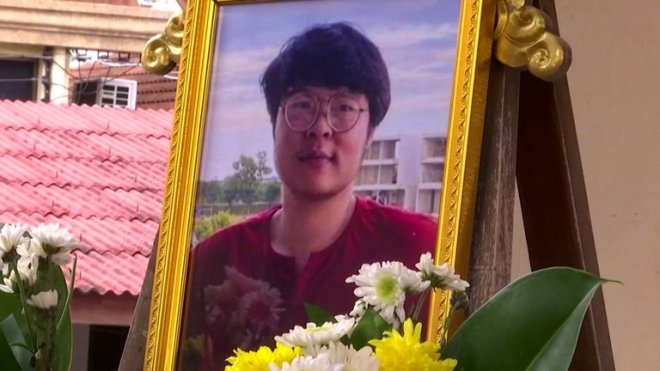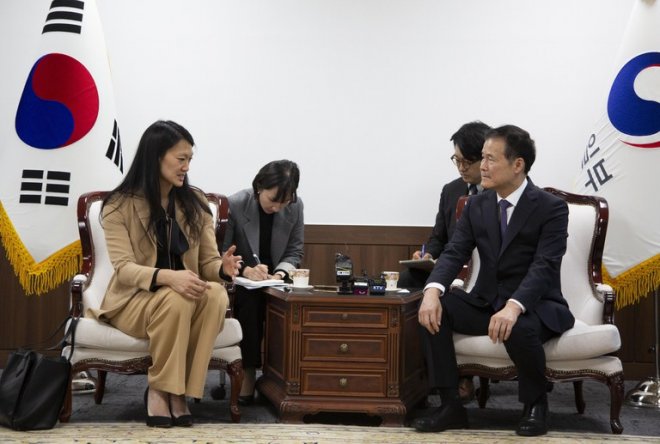Micronesia drops concerns about Japan’s plan to discharge treated nuclear water
The Federated States of Micronesia, which had denounced Japan’s plan to release water from the tsunami-damaged Fukushima Daiichi nuclear plant into the ocean, is no longer concerned following briefings from the Japanese government, its president said.Plans to discharge Fukushima water over four decades into the Pacific Ocean have been a source of tension between Japan and Pacific island nations, and a possible complication for the efforts of the United States and its allies to show a renewed commitment to the region as China’s influence grows.
“Our country is no longer fearful or concerned about this issue and now has deep trust in Japan’s intentions and technological capabilities in not harming our shared oceanic assets and resources,” Micronesia’s President David Panuelo told a Feb. 3 news conference at the Japan National Press Club.
Panuelo’s comments to the press club went further than a joint statement from a meeting between Panuelo and Japan’s Prime Minister Fumio Kishida on Feb. 2 in Tokyo.
The statement said briefings from Japan’s ambassador to Micronesia had been “extraordinarily fruitful for the FSM’s understanding of this complex issue.” It said that Micronesia “is no longer as fearful or concerned as previously related at the United Nations General Assembly.”
The Pacific Islands Forum, an organization that groups Pacific island states, and Australia and New Zealand, said on Monday its secretary general, Henry Puna, and its chairman-designate, Cook Islands Prime Minister Mark Brown, have traveled to Japan for a meeting this week with Kishida and other officials.
Puna, a fierce critic of the Fukushima discharge plan, said last month he wanted, at the very least, to delay the release of Fukushima water, which Japan has indicated could begin from April.
Japanese authorities and the Fukushima plant operator, Tokyo Electric Power Company, have said radiation released into the Pacific Ocean would be a minute fraction of naturally occurring radiation in the environment.
Nuclear legacy
Nuclear issues are particularly sensitive with Pacific island countries because of the nuclear weapons testing that was imposed on the region by the United Kingdom, France and the United States for several decades after the end of World War II.
Japan’s plan to discharge treated water from the Fukushima plants over a period comes at a time when the United States and allies such as Australia and Japan are trying to counter China’s efforts to win influence with Pacific island nations.
“Both Canberra and Washington want Tokyo to be more involved in the region,” said Tess Newton Cain, a Pacific analyst at Griffith Asia Institute. “But this issue has the potential to derail things I think. Australia is in a particularly delicate position as a member of the PIF [Pacific Islands Forum],” she said.
Micronesia, home to about 100,000 people, last month said it had negotiated increased economic assistance from the United States, which has rights to military control of Micronesia’s territory under a compact of free association.
Water contaminated by the nuclear reactors damaged in a 2011 tsunami is stored in hundreds of large tanks at the coastal Fukushima plant and Tokyo Electric has said storage capacity at the site is fast running out.
Japan’s method involves putting the contaminated water through a purification process known as the Advanced Liquid Processing System, which it says will reduce all radioactive elements except tritium to below regulatory levels.
The treated water would then be diluted by more than 100 times to reduce the level of tritium–radioactive hydrogen used to create glow-in-the-dark lighting that’s at the milder end of the radioactive spectrum.
Treatment and discharge of the water is part of a decades-long plan to decommission the Fukushima plant.
Panuelo’s visit to Japan also celebrated the 35th anniversary of diplomatic relations between the two countries and the opening of a new Micronesian embassy building in Tokyo.
The joint statement reiterated Japan’s plan to give Micronesia four patrol boats to help police the archipelago’s vast ocean territory in the north west Pacific.
Papua New Guinea’s Foreign Minister Justin Tkatchenko also appears willing to trust Japan’s assurances.
“There is no Pacific islands opposition,” he told BenarNews. “All we want is that Japan works closely with IAEA [International Atomic Energy Agency] and other scientific bodies to ensure safety comes first and contamination level is reduced.”
‘Data red herrings’
Five scientists working with the Pacific Islands Forum last month criticized the quality of data they had received from Tokyo Electric on the treated water in the tanks and expressed doubts about how well the purification process works.
Over more than four years, only a quarter of tanks had been tested for radiation, and testing rarely covered more than nine types of radiation out of 64 types that should be tested for, said the five scientists, who include Woods Hole Oceanographic Institution’s senior scientist Ken Buesseler.
They said alternative storage methods such as making concrete with the water should be investigated.
Nigel Marks, a materials scientist at Australia’s Curtin University and former nuclear reactor engineer, who is not advising the forum, criticized aspects of the panel’s presentation as containing data red herrings as well as being emotive and a form of “viewer manipulation.”
Storage in concrete is not practical because of the large quantities of water, he said. But if the panel believes storage in concrete is safe it should logically come to the same conclusion for discharge into the sea, Marks said.
“The effect of the treated wastewater release on the environment–humans and nature–will be zero,” he said. “It will not do anything.”
BenarNews is an RFA-affiliated news organization.
[圖擷取自網路,如有疑問請私訊]
|
本篇 |
不想錯過? 請追蹤FB專頁! |
| 喜歡這篇嗎?快分享吧! |
相關文章
AsianNewsCast























